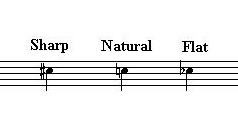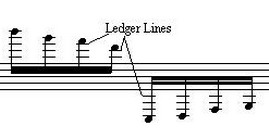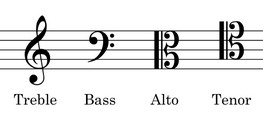It's never too late to learn how to read music, and with a little practice and tenacity, the basics can be learned quite quickly. And because knowing how to read and write music still has its benefits and uses, no matter what style of music you're into, this article has been put together to present the most important and prominent of these basics.
It’s never too late to learn how to read music, and with a little practice and tenacity, the basics can be learned quite quickly. And because knowing how to read and write music still has its benefits and uses, no matter what style of music you’re into, this article has been put together to present the most important and prominent of these basics.
Table Of Contents:
Notes – Duration Values, Tuplets, Beams, Note Names, Octave
Accidentals – Sharp, Flat, Natural, Double Accidentals
Clefs – G Clef, F Clef, C Clef
 |
They represent a sound’s duration and pitch. The duration is represented by the type of note head ( the oval part of a note), and/or it’s stem and flag. Pitch is represented by the note’s position on the staff. The higher the note on the staff, the higher the pitch, and vice versa.

1 whole note = 2 half notes = 4 quarter notes = 8 eighth notes =
16 sixteenth notes = 32 – thirty-second = 64 Sixty-fourth notes etc.
In Britain the names are different for these notes values:
whole note = semibreve, half note = minim, quarter note = crotchet, eighth note = quaver, sixteenth note = semiquaver, thirty-second = demisemiquaver, Sixty-fourth note = hemidemisemiquaver etc.
 |
A tuplet is a group of notes whose rhythm is evenly condensed or expanded over a specific duration of time. For example: a group of three eighth-notes (triplets) may be played within the space of one quarter note which is also equal to two eigth notes. A tuplet sign is normally placed above or below the group of notes.
duplet – two
triplet – three
quadruplet – four
quintuplet – five
sextuplet – six
septuplet – seven
Etc.
For more complicated tuplets, the number indicates a ratio, where the first number should have the same duration as the second. So 5:4 written above a group of 5 sixteenth notes ( a quintuplet) means that these 5 sixteenth notes should be condensed and have the same duration as 4 sixteenth notes.
 |
When stems are next to each other, they can be beamed (grouped ) together.
There are seven names of notes, each represented by a letter: C D E F G A B (in that order). In many countries these notes are named: Do or UT, Re, Mi, Fa, Sol, La, Si. These names are said to have come from the first syllables of the verses of a hymn to Saint Jean composed by Gui d’Arezzo (Xth century).
UT queant laxis/ REsonare libris/ MIra gestorum/ FAmuli tuorum/ SOLve polluti/ LAbi reatum / Sancte Iohannes.
 |
An octave is the distance separating two notes having the same name. The name “octave”comes from the Latin octavus, from octo (meaning eight).
An accidental is a symbol that changes the pitch of the note. Accidentals affect only those notes which they immediately precede, and those notes that are within the same measure. There are three types of accidentals:
 |
The sharp raises (“sharpens”) the note by a half-step
The flat lowers (flattens) the note by a half-step
The natural restores the note to its original “natura” state by canceling the sharp or flat.
Double accidentals: they raise or lower the pitch of a note by two half-steps ( a whole-step). A C with a double sharp applied raises it a whole step so it is enharmonically equivalent to a D. Though this might seem confusing for some, the use of double accidentals can sometimes make more sense in certain contexts.
They are made up of five lines that are horizontal, parallel and equidistant and which form four spaces between the lines. Notes, clefs, rests, and accidentals are the main symbols found on a Staff.
Notes are placed on a staff: either on the lines or between them, or above the top (1st) line or below the bottom (5th) line. Other notes can be written above or below the staff by using ledger lines.
 |
 |
Ledger lines are used to write notes outside the lines and spaces of the staff. They are slightly longer than the note and are parallel to the staff, above or below, and evenly spaced. They are more difficult to read than notes within a staff so sometimes if there are many, a change of clef if preferable.
 |
Measure/bar lines perpendicularly (vertically) cross the staff. Everything found between the two barlines makes up a bar/measure.
 |
A Clef is placed at the beginning of a staff and indicates the name and pitch of the notes on that line. This line then serves as a reference point by which the names of the notes on any other line or space of the same staff may be determined. The main reason that different clefs were used was to try and center an instrument’s (or voice’s) range on the staff and in the process avoid using too many ledger lines.
 |
G Clef (also called the treble clef): is placed around the second line from the bottom and is used for high sounds.:
violin, flutes, oboe, English horn, all clarinets, all saxophones, horn,, trumpet, guitar, vibraphone, xylophone; upper part of keyboard instruments like the piano, organ, harp, and harpsichord (of which the lower part is usually written in the bass clef); for the highest notes played by the cello (the old convention was to write an octave higher, unless preceded by a tenor clef), bassoon, trombone (which otherwise use the bass and tenor clefs), and viola (which otherwise uses the alto clef); and for the soprano, mezzo-soprano, alto, and tenor voices.
The notes starting on the bottom line bottom to top line are:
E, F, G, A, B, C, D, E, F
 |
F Clef (also called the bass clef): is placed on the 4th line. This is more or less the only F-clef still used today, so that the terms “F-clef” and “bass clef” are often regarded as being the same.
This clef is used for the cello, double bass, bass guitar, bassoon, contrabassoon, trombone, tuba, and timpani; for the lower part of keyboard instruments like the piano, organ, marimba and harpsichord (of which the upper part is usually written in treble clef); and for the lowest notes of the horn; and the baritone and bass voices.
The notes starting on the bottom line bottom to top line are:
G, A, B, C, D, E, F, G, A
 |
C Clef It is called the alto clef when it’s placed on the third line of the staff. This line indicates the position of middle C As it does with all C-clefs.
This clef (sometimes called the viola clef) is currently used for the viola and the alto trombone. Before, it was used for alto voices and by instruments playing a middle part (oboes, recorders, etc
The notes starting on the bottom line bottom to top line are:
F, G, A, B, C, D, E, F, G
When the C-Clef is placed on other lines it is know by other names:
Tenor Clef (fourth line), baritone-clef (fifth line), soprano clef (first line)…
Keep in mind that every clef, of course, changes the note positions.
Rests indicate a silence or pause of a sound. These are marked by a symbol indicating the length of the pause.
The different rest symbols correspond to the note symbols and have the same duration.
 |
Here are corresponding note and rest values:
 |
Shows how many beats are in each measure and what note value makes up one beat. Most time signatures are made up of two numbers, one above the other. They are written like a fraction but no line appears between the numbers when written in the music. The upper number indicates the number of beats, while the lower number shows the note value making up a beat. Example: 4/4 = four quarter notes per measure, 3/4 = three quarter notes per measure. The time signature appears at the beginning of the piece. A time signature after that, usually immediately after a barline, shows a change of time signature.
Some frequent time signatures:
 |
4/4 also called common time: widely used in all styles of music.
2/2 alla breve, cut time: used frequently for marches and fast music.
3/4 used for waltzes, minuets and jazz waltzes and some ballads.
6/8 double jigs, polkas, Spanish / South American music and some rock music etc.
A Key Signature is a series of accidentals (either sharps or flats) placed on the staff, showing notes that are to be consistently altered one half-step higher or lower than the equivalent natural notes. Key signatures are generally written immediately after the clef at the beginning of a line, although they can appear in other parts of a score, notably after a double bar to indicate a change in key.
Key signatures are used to avoid the complication of always having to sharp or flat certain notes, especially owing to the fact that each major and minor key has an associated key signature used to show which notes are usually sharp or flat in that key or scale.
 |
